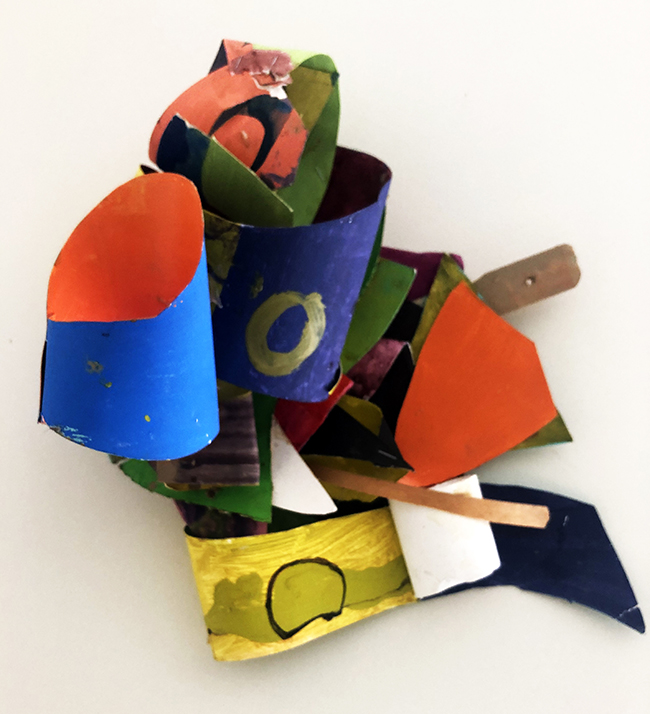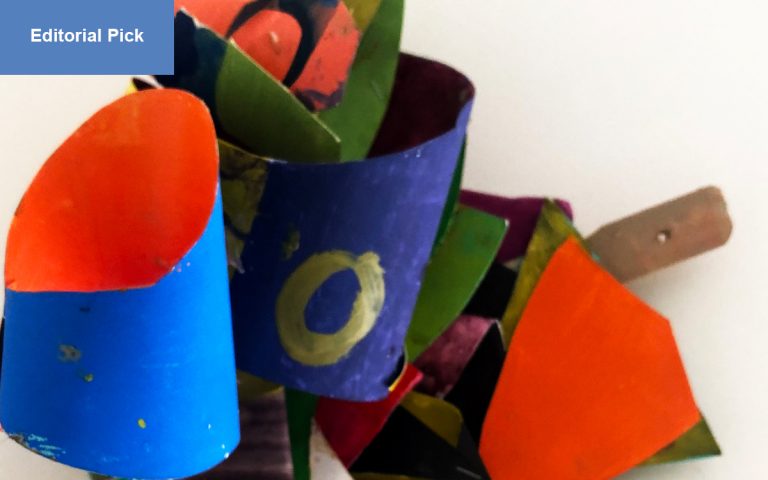Mitchell Rosenzweig is an experienced artist whose abstract mixed media paintings don’t demand attention—they earn it. At first glance, they might appear spontaneous, but beneath the surface lies a solid framework. Layers of paint, scraps of paper, and fragments of material stack together like strata, settling into a careful order. His work isn’t about random piling; it’s structure with intent. The surfaces he builds form a kind of visual scaffolding that holds everything in balance. Each piece grows from this process, where chance and deliberation meet, and where accidents are absorbed into design. Rosenzweig’s art doesn’t chase spectacle. It develops slowly, patiently, with each mark and material leaning on the last, until the whole feels inevitable. The result is work that sustains attention—because it’s built to.

The Work: Zero
Rosenzweig’s piece Zero measures 20″ x 13″ x 5″ and is made of paper and wood. It is not a painting, but a three-dimensional wall-hung sculpture that serves as a precursor to his painted work. In Zero, the artist stages a kind of rehearsal for what later happens on canvas. Shapes and colors collide in space, producing a dialogue of form that pushes beyond the flat surface. It is both study and statement, reminding us that painting does not have to be confined to two dimensions.
The construction reveals Rosenzweig’s method. Painted paper is cut, bent, and folded into irregular sections. These fragments are then layered together, supported by strips of wood that act like joints in a skeletal framework. The composition becomes a hybrid—part collage, part relief sculpture. Each section holds its own energy, yet contributes to the overall balance. The orange curves, blue blocks, and green folds create contrast and rhythm, while the occasional raw edges and brush marks keep the piece grounded in process. This is not a polished object pretending to be seamless. It’s a structure where every layer remembers its own making.
Color as Structure
The color in Zero is more than decoration—it’s part of the architecture. Rosenzweig uses bold, unblended hues, often set against one another in sharp juxtaposition. A bright orange curve plays off a deep blue form. Yellow collides with green, purple with black. Instead of harmonizing, the colors compete for space, and it’s this competition that generates vitality. Each shape seems to press against the others, like tectonic plates. The result is tension contained within a compact form, as though the work is bracing against collapse yet holding together.
In this way, Zero demonstrates how Rosenzweig treats color as a structural element rather than an afterthought. The hues do not just sit on top of the material—they anchor it, define it, and give it force. This approach carries into his paintings, where the push and pull of color maintains the underlying scaffolding of each piece.
Sculpture as Precursor
Rosenzweig has said that works like Zero are precursors for his paintings. That relationship is clear. The sculpture behaves like a sketch in three dimensions. It tests what happens when forms overlap, when colors press against one another, when shapes cut into space instead of staying flat. In this way, the wall-hanging sculptures operate as laboratories. They allow Rosenzweig to experiment freely, without the conventions of painting, while still remaining tethered to it.
The piece also reflects his interest in how material itself carries meaning. Paper and wood are ordinary, even fragile, yet in Rosenzweig’s hands they become the basis for something sturdier. By layering, bending, and arranging them, he turns disposable matter into enduring structure. This transformation echoes the way sediment forms rock: accumulation becomes foundation.
Beyond Zero
Although Zero is compact in size, it points outward to Rosenzweig’s broader practice. His paintings bear the same sensibility—layered surfaces that feel built rather than painted, structures where color and form hold weight. What begins as sculpture reemerges on canvas, not as imitation but as continuation. The work resists hierarchy between media; sculpture and painting feed each other, forming one continuous exploration.
The piece also invites reflection on the title itself. Zero suggests beginning, ground level, the point before one. It’s an apt name for a work that serves as a precursor. Just as zero is both nothing and the foundation for everything, this sculpture is modest in scale but full of potential energy. It carries the seeds of later paintings while standing firmly as its own completed work.
Conclusion
Mitchell Rosenzweig’s Zero is more than a small wall-hanging sculpture. It is a statement of method, a declaration of how material, color, and form can be tested and layered into meaning. By working in three dimensions, Rosenzweig shows how his art is built, not merely painted—how each surface, each scrap, each curve contributes to an overall architecture of attention. In Zero, he reduces the process to essentials, making visible the quiet scaffolding that underlies his entire practice.

